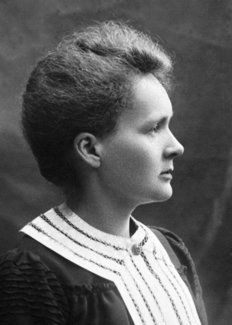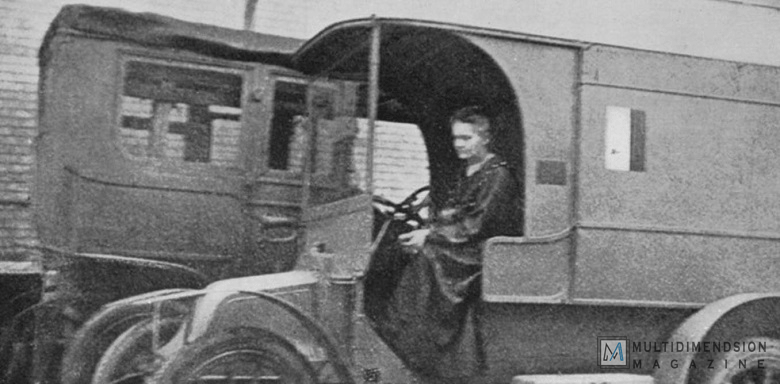Written By: Sayantan Datta, Bishal Dey
Hyderabad, India
Commemorating 151 years of Madam Curie (Born- November 7, 1867; Died- July 4, 1934)
She now lies, probably in peace and inquisitiveness, in the Panthéon, Paris. Her bones and blood now finally relieved to be away from the dangers of ionizing radiation and the consequences of it – Madame Curie’s body can never be as immortal as herself. With a legacy that spans eternity (in great irony to the half-life of the substances she worked with), she can be arguably understood as not just an important woman figure in life, but for us feminists (and some of us who have managed to survive in science), an important deviation from the then popularised scientific framework. We cannot claim to have a nuanced political critique of her life and whatever history survives of her life (women in science and their lives can easily be pushed, at least partially, in oblivion) – we know too less – but what we do understand is that Marie Sklodowska Curie is an important reminder of how many things a woman can unsettle through the act of mere existence. Her legacy also stands as an ungentle reminder of how we need to consciously critique science from within its framework for any scientific progress to be derived from a sociopolitical space. We shall try to come back to these points as we touch upon Marie Curie’s life and interpret the important events in the scope of our own understandings. We will follow Marie’s own words as we recount how she spins her tale, “Nothing in life is to be feared, it is only to be understood. Now is the time to understand more, so that we may fear less.”

Marie’s (then Maria) life was almost entirely left marked with the history that was a recent precedence to her birth – the occupation of Warsaw, her place of birth, as a result of Poland’s defeat to Czarist Russia. This political repression (to use a word from psychoanalysis), remained to influence Marie so much so that there have been innumerable instances where she has been guided by her subconscious into participating with her scientific acumen to benefit soldiers in the war. For women of her times, oblivion meant not just a space to be pushed into, but also a space to occupy, and for women with a passion of being in science like her, she trained herself in oblivion, guided and motivated by her passion and motivation. She was trained initially in experimental chemistry in secrecy by her cousin Jozef Buguski. With the meagre savings that she had accumulated through her work as a Governess, she could finally take a trip to Paris and enrolled herself at Sorbonne. Sorbonne, although nominally open to women, was not outside the structures of patriarchy and misogyny, and the structural and systemic exclusion ensured that almost no woman ever got admission. In fact, Marie was one of the two women recipients of her degree in Sciences, and one of the five women recipients in Mathematics. This shall always act as a reminder of not just oblivion but also solitude – spaces which the oppressed have used to write their own stories. We need to remember that even after she married her husband Pierre Curie, celebrated physicist at that time already, and had moved into a small 3 room apartment with him, her laboratory for very long time was an oblivious storeroom converted into the altar of science. This celebration of the oblivion, however, should be always remembered with the exclusion that pushes women into the domains of obscurity. Marie Curie’s work therefore, not only becomes a way of immortalising her but also politically immortalising the zeal to dismantle systemic structures of oppression.
There’s more to understanding Marie Curie’s science through a political framework – her subversion of the notion of motherhood. When she was taking up the humongous task of beginning her work on radioactivity (for which she later won two Nobel Prizes), her first child Irene had already been born. This point of Marie’s life has been looked at by multiple biographers, but we feel it is necessary to not just look at it as an un-nuanced political event. Our feminism(s) have taught us to identify and analyse doctrines that guide science, and science, like any other social force, cannot stand outside politics. Marie’s motherhood was interpreted as an easy deterrent for her science, not unexpectedly so, especially in the wake of the time when people were still expecting her to not finish her thesis, in the wake of her new found motherhood, as if motherhood is freedom and liberation. Marie on the other hand, chose to stick to science and certainly obtained her doctoral degree. Not just that, she was also awarded two Nobel Prizes. Marie, therefore, also becomes the mother who doesn’t stay calm at home – her furious curiosity breaks all barriers and unleashes the power of certain femininities that have been contained in the social margins.
We shall also touch upon our readings of two more important events in Marie’s life – her affair with Paul Langevin, 5 years her junior, and her immense involvement in the World War 1. Four years after the death of Pierre Curie, Marie was alleged to be in an affair with fellow scientist Paul Langevin. Paul happened to be a student of Pierre’s. Marie couldn’t foresee (interestingly) the eruption that this scandal might cause, and soon saw an angry mob gathered outside her house, terrorising her children based on the ‘tarnish’ that the ‘widow had brought upon her deceased husband’. Marie still remained undeterred in her quest for love and passion – the construction of morality was challenged by her beyond her laboratory. Marie’s personal life therefore can also be read as a political act in its challenge to the society’s moralistic construction of a de-sexualised widow – truly Marie showed how the personal is political before the slogan was probably even coined. The then French society did not forget (and certainly not forgive) her liberated move of passion before Marie’s ‘heroic’ involvement in the World War 1, when she made mobile X-Ray machines which could serve the soldiers. This becomes an interesting space for intersectional analyses – the war and involvement in it is the purifier for the woman’s crime of losing her widowed chastity? Marie’s life remains glowing not only because of the radiation it emits, but because of multiple such complex questions it allows us to address. She shall always remain immortal and her her story can only be rewritten.
References:
1) Pasachoff, Naomi. Marie Curie: And the science of radioactivity. Oxford University Press, 1996.




